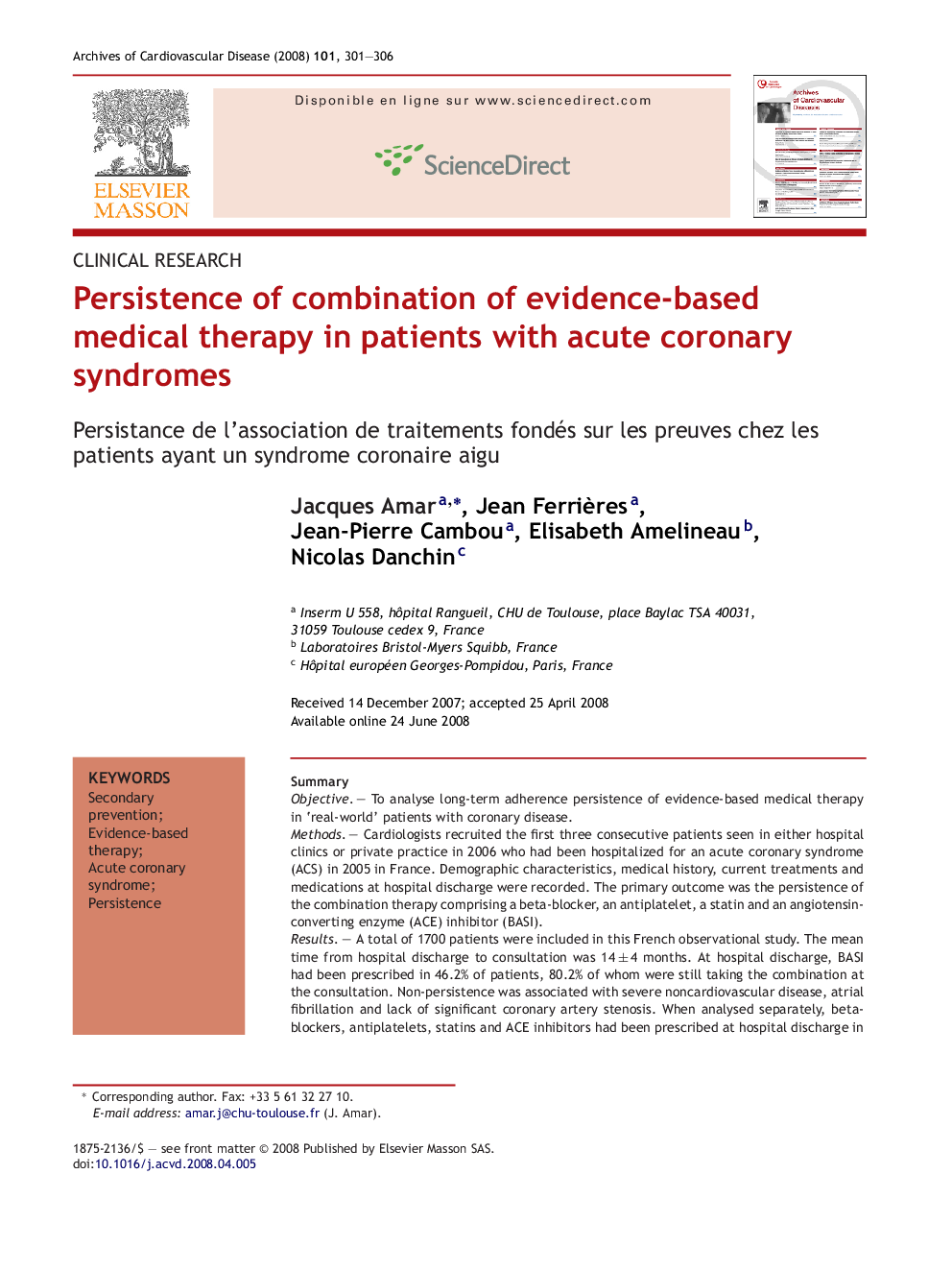| کد مقاله | کد نشریه | سال انتشار | مقاله انگلیسی | نسخه تمام متن |
|---|---|---|---|---|
| 2889709 | 1574415 | 2008 | 6 صفحه PDF | دانلود رایگان |

SummaryObjectiveTo analyse long-term adherence persistence of evidence-based medical therapy in ‘real-world’ patients with coronary disease.MethodsCardiologists recruited the first three consecutive patients seen in either hospital clinics or private practice in 2006 who had been hospitalized for an acute coronary syndrome (ACS) in 2005 in France. Demographic characteristics, medical history, current treatments and medications at hospital discharge were recorded. The primary outcome was the persistence of the combination therapy comprising a beta-blocker, an antiplatelet, a statin and an angiotensin-converting enzyme (ACE) inhibitor (BASI).ResultsA total of 1700 patients were included in this French observational study. The mean time from hospital discharge to consultation was 14 ± 4 months. At hospital discharge, BASI had been prescribed in 46.2% of patients, 80.2% of whom were still taking the combination at the consultation. Non-persistence was associated with severe noncardiovascular disease, atrial fibrillation and lack of significant coronary artery stenosis. When analysed separately, beta-blockers, antiplatelets, statins and ACE inhibitors had been prescribed at hospital discharge in 82.4, 98.9, 89.2 and 58%, respectively. Persistence over the 14-months period was greater than 86% for each of the drug classes. After hospital discharge, BASI was initiated in 8.5% of patients. Fourteen months after hospitalization for an ACS, 45.6% of patients were taking BASI.ConclusionsLong-term persistence of BASI remained high after hospital discharge for an ACS, whereas the combination was started in a minority of those not discharged on this treatment. Fourteen months after an ACS, only half of the patients were receiving BASI, mainly due to failure to prescribe an ACE inhibitor at discharge. Our results highlight the importance of hospital prescription of BASI to obtain long-term persistence in ACS.
RésuméBut de l’étudeAnalyser la persistance sur le long terme des traitements fondés sur les preuves chez les patients ayant présenté un syndrome coronaire aigu.MéthodesIl s’agit d’une étude observationnelle conduite en France en 2006 par des cardiologues exerçant en secteur libéral ou hospitalier. Chaque investigateur devait inclure les trois premiers patients reçus en consultation et ayant été hospitalisés en 2005 pour un syndrome coronaire aigu. Les caractéristiques cliniques, les traitements à la sortie de l’hôpital et en cours le jour de la consultation d’inclusion étaient colligés. Le critère principal d’évaluation était la persistance de la combinaison thérapeutique : bêtabloquant, antiagrégant plaquettaire, statine, inhibiteur de l’enzyme de conversion (BASI).Résultats1700 patients ont été inclus. La durée moyenne entre la sortie de l’hôpital et l’inclusion était de 14 ± 4 mois. À la sortie de l’hôpital, le traitement BASI était prescrit chez 46,2 % des patients et 80,2 % d’entre eux recevaient encore le traitement BASI lors de l’inclusion. La non persistance du traitement BASI était corrélée avec la présence d’une pathologie sévère non cardiovasculaire, d’une fibrillation auriculaire et l’absence de sténose significative des artères coronaires. Analysés séparément, les bêtabloquants, les antiagrégants plaquettaires, les statines et les inhibiteurs de l’enzyme de conversion étaient respectivement prescrits à la sortie de l’hôpital chez 82,4, 98,9, 89,2 et 58 % des patients. Après la sortie de l’hôpital, le traitement BASI était initié chez 8,5 % des patients.ConclusionLa persistance du traitement BASI est importante lorsqu’il est prescrit à la sortie de l’hôpital, alors qu’il n’est initié que chez une minorité de patients qui ne le reçoit pas à leur sortie d’hôpital. Quatorze mois après une hospitalisation pour un syndrome coronaire aigu, seulement la moitié des patients reçoit un traitement par BASI, principalement en raison d’un défaut de prescription d’un inhibiteur de l’enzyme de conversion à leur sortie de l’hôpital.
Journal: Archives of Cardiovascular Diseases - Volume 101, Issue 5, May 2008, Pages 301–306